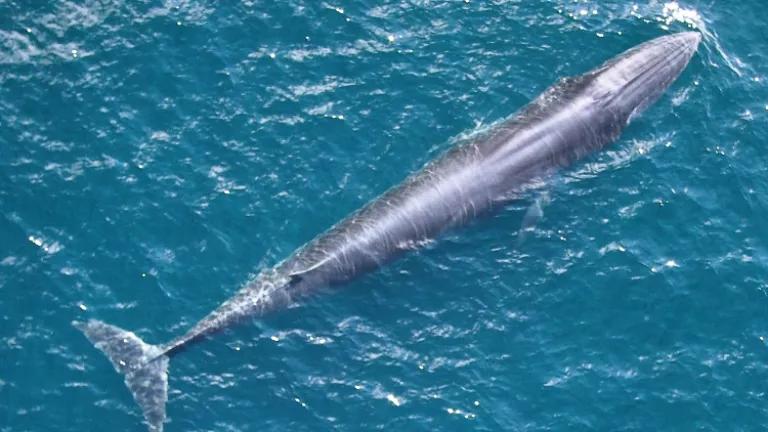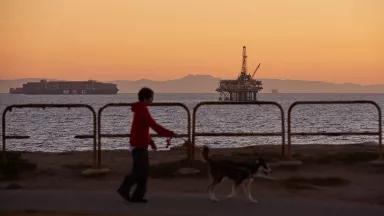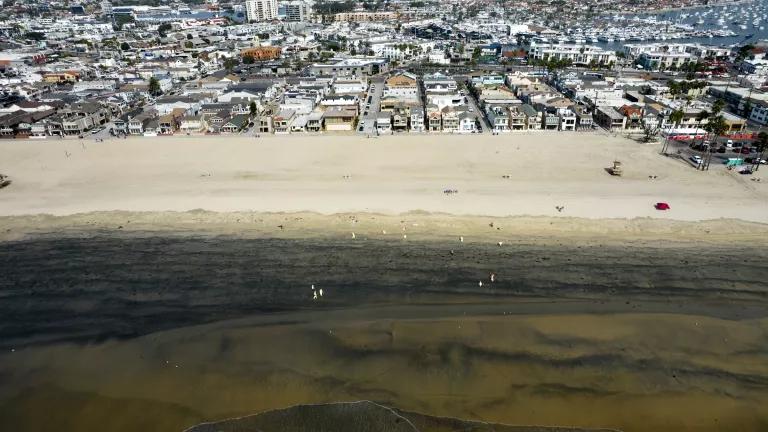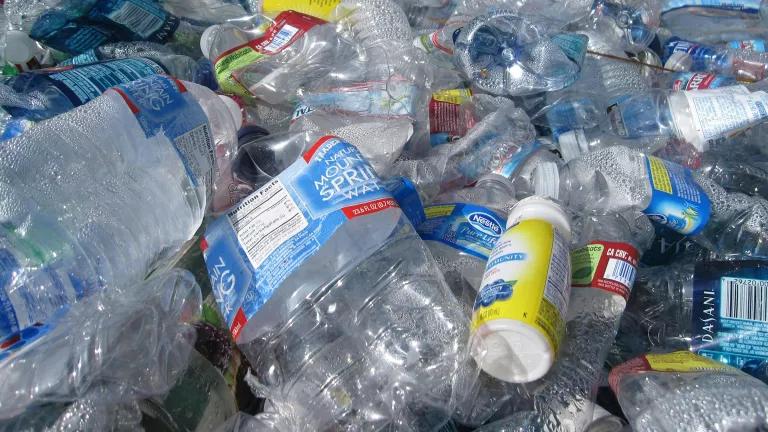The Biden Administration’s Risky Offshore Leasing Plan
The Biden administration's offshore oil and gas leasing plan places communities and environments at risk.
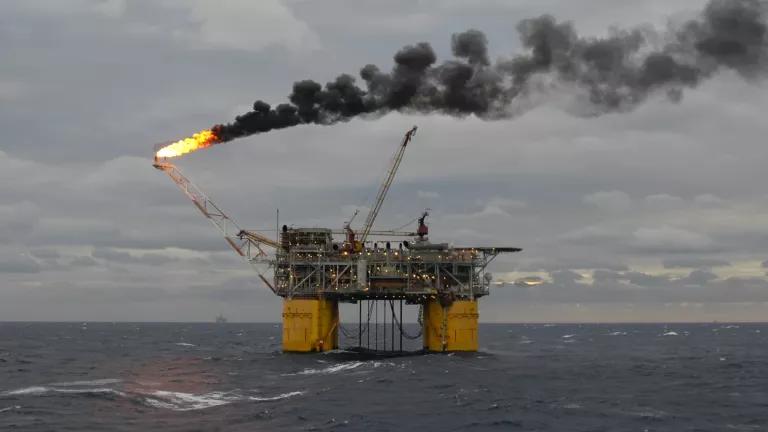
An offshore oil platform with a gas flare in the Gulf of Mexico
iStock
After another summer of devastating fires, storms, and other climate change–fueled natural disasters around the nation, the Biden administration recently released a federal offshore leasing program that will allow offshore oil and gas development in the Gulf of Mexico for decades to come.
NRDC shared an initial reaction after the plan was released, and I’ll do a deeper dive here about the details of the program and our concerns.
The plan recognizes the need to ramp down on fossil fuels
The Bureau of Ocean Energy Management’s (BOEM) program sets the schedule for oil and gas lease sales on the Outer Continental Shelf for the next five years. BOEM’s program—with three Gulf of Mexico lease sales to take place in 2025, 2027, and 2029—contains the fewest number of sales ever. BOEM did not schedule any sales for Cook Inlet or other areas in Alaska.
In deciding how many lease sales to include in the program, BOEM is required by law to consider various factors, including U.S. energy needs, the coastal and marine environment, and economic costs and benefits. More than ever before, the new leasing program acknowledges that national energy needs are changing in response to a decarbonizing economy, and that continuing oil and gas production will result in serious economic costs. BOEM determined that three new lease sales, plus continuing development of oil and gas reserves on existing leases, were enough to meet the country’s energy needs for the near term and noted the importance of factoring in the transition to a lower carbon emissions economy. BOEM also recognized that issuing offshore renewable energy leases is an important part of the national energy needs determination. And, unlike in past programs, BOEM assigned a social cost metric to the end uses of fossil fuel production, like driving and power generation. Ultimately, BOEM concluded that this plan for three sales “reflects the proper balance of the potential for environmental damage, discovery of oil and natural gas, and adverse impact to the coastal zone.”
BOEM still fails to prevent severe risks to Gulf communities and the Gulf ecosystem
BOEM failed to use its full discretion to protect communities and prevent environmental harms. In our comments to the proposed program and in other advocacy, we urged BOEM to issue a program with no new lease sales. The agency has ample authority to do so. Further, declining fossil fuel demand and existing energy reserves mean that no new offshore leasing is needed for at least the next 30 years to meet national energy needs. BOEM could have issued a zero-lease sale plan, but declined to do so, despite calls from a wide range of community and environmental groups for no new leasing in the Gulf.
What’s more, BOEM’s energy math is still faulty. The agency overestimates the need for increased oil and gas leasing and fails to fully account for the rate of the transition to a low-carbon economy. Using the U.S. Energy Information Administration’s (EIA) 2023 Annual Energy Outlook (AEO) as the base case for modeling future energy supply and demand, BOEM found that energy consumption would increase, leading into 2050, and that by 2050, petroleum and other fossil fuels would account for more than 69 percent of energy consumption and power 90 percent of the transportation sector.
However, as my colleague Rebecca Loomis has written recently, NRDC commissioned more robust modeling of the effects of decarbonization policies like the Inflation Reduction Act tax credits, the new clean transportation rules, and a no-leasing program on future U.S. oil needs. We used the same AEO 2023 base case as BOEM did, but we reached fundamentally different results. By contrast, our modeling shows lower rates of oil consumption in 2035 and beyond: We found that by 2035, U.S. oil consumption would decrease by 10 percent, and that by 2050, consumption would decrease by 19 percent. We also found that no new leasing would have little practical effect—existing leases are enough to meet U.S. needs for the next 30 years, and oil production even climbs, leading into 2050.
BOEM continues to treat the Gulf as a region where community health and well-being can be sacrificed to allow continued oil and gas production. In its analysis of the risks and benefits of additional leasing in the Gulf, BOEM found a net benefit to continuing oil and gas production in the area, citing the oil and gas industry contribution to local and regional employment opportunities, state and local government revenue, and the proximity of energy supplies to consumers. Yet the program ignores the environmental justice impacts of leasing, deferring this analysis to a later date.
BOEM’s clinical calculation fails to account for the real costs of the petrochemical industry in the region: disproportionate health burdens on communities adjacent to refineries, including greatly increased cancer risks; increased incidence of cardiovascular and respiratory conditions; and increased risk of air and groundwater contamination. It also ignores the economic benefits, which we referenced in our comments, of transitioning to a clean energy economy, which will generate around three million supply-side energy jobs and enable oil industry workers to transfer their skills to work in a different sector.
BOEM also fails to account for the severe risks from additional oil and gas leasing to the Gulf ecosystem and species like the critically endangered Rice’s whale. BOEM fails to include the Rice’s whale—the most vulnerable species in the region—as part of its environmental sensitivity analysis. The program also neglects to enumerate the economic costs of losing protected species or critical habitat. BOEM’s analysis also treats catastrophic oil spills like the Deepwater Horizon disaster as events that are speculative and unlikely to repeat again, and the program excludes such spills from its analysis.
By leaving out these critical considerations, BOEM’s analysis ignores the real threats that oil and gas development poses to the Gulf Coast ecosystem. The Rice’s whale is struggling to survive, with around 50 individuals left. Without additional safeguards, its very existence will be threatened by continued oil and gas development. Further, as oil and gas operators increasingly buy leases in deeper waters, the risks of oil and gas development and catastrophic incidents increase—greater reservoir pressure and temperature, unstable rock and sediment, and more stresses on pipeline infrastructure all increase blowout risk and the possibility of another severe oil spill.
Next steps in the fight
Congress and the White House are currently reviewing BOEM’s plan, and the agency will likely issue a final approved version of the program in early December.
As it moves forward with implementing the next oil and gas leasing program, BOEM has the power to minimize the risks of oil and gas development: It can cancel lease sales, set additional lease terms to protect communities and vulnerable species like the Rice’s whale, and make companies pay the real costs of continuing to develop the fossil fuel industry in our oceans.
NRDC will be watching BOEM’s next moves and standing up for communities and vulnerable species.
This blog provides general information, not legal advice. If you need legal help, please consult a lawyer in your state.
Only 50 Rice’s whales are left on the planet.
Tell Secretary of Commerce Gina Raimondo to protect these imperiled whales from extinction!
